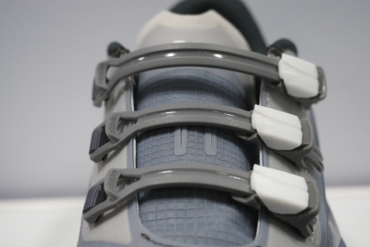
By Kelly Agnew
As a habitual minimalist runner, I never imagined myself writing about thick-soled, “maximalist“ running shoes, let alone actually wearing them.
Times change. We age, we grow, we experiment, we learn and hopefully become better at the things we love. That’s how I found myself wearing the Altra Olympus, a shoe that, despite having a massive 36mm-thick sole, still weighs in at a respectable 11oz.
I run 100-mile races — a lot of them in rapid succession. Last year I ran in 38 races including 26 ultra marathons, nine of which were 100+ mile races. This can take a toll on the body.
Check out Kelly’s 1,000 mile test of the Osprey Rev 1.5 hydration pack.

After running the Across The Years 48 Hour Race in December, I found my feet and legs badly damaged from more than 200 miles in a single push. I had never run beyond 100 miles prior to that and when I do run 100-mile races, they usually end well under 24 hours. The time on my feet was a new experience and my body paid a steep price.
So when I signed up for the Pickled Feet 24 Hour Race, another opportunity to go past the 100 mile mark, I saw a chance to test the Altra Olympus with the hope that they would protect my feet on the super-long slog while keeping me healthy for another upcoming race.

Not only did I want to do well in the Pickled Feet, but I also had my eye on returning to the Zion 100 Trail Run the following weekend. This is one of my favorite events and I was insistent on running these races on consecutive weekends.
Hoping for feet that could do back-to-back 100 milers, I reluctantly strapped on the fat-soled Altras.
I was almost embarrassed when I first slid them on. Walking around felt awkward and foreign. Running, however, did not.

My feet, legs and stride felt natural and comfortable. Despite being a much more substantial shoe, they weigh a mere 11 ounces, which is comparable to the more minimalist shoes I usually wear. My feet felt free and ironically more like a barefoot than maximal shoe experience, which really surprised me considering the 36mm stack height on the Olympus.
My normal running shoes have between a 4mm and 10mm heel drop, so I was a little worried about shifting to the Zero Drop shoe, especially without prior conditioning. As it turned out, it was a seamless transition and I never experienced any pain or discomfort making the change.
I expected the shoes to feel clunky and awkward and I was fearful of possible ankle rolling. I was surprised that none of those concerns materialized. After a mile or two, the shoes didn’t feel any taller or more substantial than other mid-weight running shoes in my lineup.
I did notice that my gait shortened slightly, which I expected because the shoe is designed to prevent over striding. I’m a solid forefoot striker and to maintain that footfall required a slightly shorter stride. In my normal running gait, I was landing just behind the ball of my foot in the Olympus, but not quite a mid-foot strike. Either stride was comfortable and effective, it just became a matter of finding the greatest efficiency for my effort, which came to me quickly.
I wore the Olympus during my 24-hour race, which consisted of a 2.5-mile trail loop with a mixture of rock, sand, dirt and a short stretch of asphalt. The shoes handled well, felt light and comfortable and kept my feet in perfect condition. I went on to win that race with 130.13 miles, setting a new course record and 100 mile PR along the way.
I was delighted with the performance of the shoe but the real test was still to come.
Continue on page 2 for testing from the Zion 100 Trail Run.






